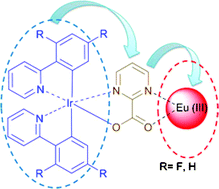 In this Dalton Transactions HOT article, Chinese researchers designed and synthesized two novel iridium(III) complexes, [Ir(dfppy)2(pmc)] and [Ir(ppy)2(pmc)] (dfppy = 2-(4′,6′-difluoro-phenyl)pyridine, ppy = 1-phenyl-pyridine), using 2-carboxyl-pyrimidine (Hpmc) as an ancillary ligand.
In this Dalton Transactions HOT article, Chinese researchers designed and synthesized two novel iridium(III) complexes, [Ir(dfppy)2(pmc)] and [Ir(ppy)2(pmc)] (dfppy = 2-(4′,6′-difluoro-phenyl)pyridine, ppy = 1-phenyl-pyridine), using 2-carboxyl-pyrimidine (Hpmc) as an ancillary ligand.
Photophysical and theoretical studies indicated that the key to designing a heteronuclear complex
with efficient energy transfer between the complex “ligand” and europium ion is matching of the energy levels. This important finding opens the way for potentially designing more biologically applicable devices as the photon exciton energy needed which can be harmful for such applications can be minimised.
Read more for FREE until 8th April 2011 at:
Synthesis, characteristics and photoluminescent properties of novel Ir–Eu heteronuclear complexes containing 2-carboxyl-pyrimidine as a bridging ligand
Ping Lian, Huibo Wei, Chen Zheng, Yifan Nie, Jiang Bian, Zuqiang Bian and Chunhui Huang
Dalton Trans., 2011, Advance Article
DOI: 10.1039/C0DT01592J, Paper










